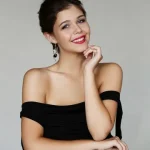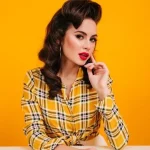The 1920s, also known as the Roaring Twenties, was a decade of dramatic change. After the social constraints of World War I, women embraced a newfound freedom and independence. This liberation extended to their fashion choices, most notably their hairstyles. Gone were the long, flowing locks of the Victorian era. In their place came a revolution in haircuts and styles that continue to inspire even today.
Embracing the Bob: A Signature of the Twenties
The bob haircut became the defining hairstyle of the 1920s. It symbolized a break from tradition and a new era for women. Here are some variations of the bob that reigned supreme:
-
The Classic Bob:
This bob cut reached the chin or jawline and was often blunt cut with a straight across fringe. Actresses like Louise Brooks popularized this sleek and sophisticated look.
-
The Shingle Bob:
This bob was slightly shorter than the classic bob, ending at the nape of the neck. It gained immense popularity due to its association with silent film star Clara Bow.
-
The Wavy Bob:
As the decade progressed, bobs evolved to incorporate more movement. Women began styling their bobs with waves and curls, adding a touch of softness to the geometric shape.
Beyond the Bob: Exploring Other 1920s Hairstyles
While the bob was undoubtedly the most prominent style, other options offered variety for women of the 1920s:
-
The Eton Crop:
This daringly short cut was inspired by the hairstyles of Eton schoolboys. It involved cutting the hair above the ears and sometimes even shaving the back, with some wispy curls left for a feminine touch.
-
Pixie Cuts:
Although pixie cuts wouldn’t become mainstream until the 1950s, trendsetters like Josephine Baker rocked a short, cropped style that resembled the modern pixie.
-
Finger Waves:
The epitome of 1920s glamour, finger waves were created by using setting lotion and styling hair into S-shaped waves. These waves were meticulously sculpted and secured with clips, framing the face beautifully.
-
Long Hair with Flair:
Even with the bob’s dominance, long hair remained an option. Women with long locks styled them in various ways, including
Achieving the Look: Techniques and Tools of the 1920s
Creating these iconic hairstyles often required specific tools and techniques:
-
Marcel Iron: This heated styling tool was used to create finger waves and other structured curls.
-
Setting Lotions: These lotions helped hair hold its style and achieve the desired shape.
-
Bobby Pins: Essential for securing finger waves, updos, and faux bobs, bobby pins were a hairstylist’s best friend.
-
Headbands and Decorative Combs: Hair accessories like headbands and decorative combs added a touch of glamour and complemented the geometric shapes of the hairstyles.
1920s Inspiration for Today’s Hairstyles
The 1920s continue to be a source of inspiration for modern hairstylists and fashionistas. Here’s how you can incorporate these vintage looks into your own style:
-
Modern Bobs: The bob haircut remains a popular choice today, with countless variations to suit different face shapes and hair textures.
-
Finger Waves for Special Occasions: Finger waves add a touch of vintage Hollywood glam to any updo or hairstyle, perfect for a special event.
-
Headbands and Hair Accessories: Headbands and decorative combs are a simple way to add a touch of 1920s flair to your everyday hairstyle.
-
Vintage Curls and Waves: Curls and waves of all shapes and sizes were popular in the 1920s. Experiment with different curling techniques to achieve a vintage-inspired look.
Whether you’re looking for a complete 1920s transformation or just a subtle nod to the era, these hairstyles offer endless possibilities. With a little creativity and inspiration from the past, you can create a unique and glamorous look that’s perfect for the modern you.
Long Hair, Timeless Beauty:
Contrary to popular belief, long hair did not fall out of favor during the 1920s; rather, it underwent a transformation to suit the prevailing aesthetic of the era. Women with long hair embraced creative styling techniques to emulate the look of shorter hairstyles, such as the faux bob. By pinning their hair up and styling the sides with curls or finger waves, they achieved the illusion of a bob cut without sacrificing their hair’s length.
Vintage Curls and Updos: A Testament to Timeless Elegance:
Beyond the iconic bob cuts and pixie styles, vintage curls and updos offered women a myriad of options for formal occasions and everyday wear alike. Finger waves, characterized by their distinctive S-shaped pattern, became synonymous with glamour and sophistication, adorning the heads of Hollywood starlets and socialites alike. Whether worn loose and cascading or swept up into an elegant updo, vintage curls and updos epitomized the timeless elegance of 1920s fashion.
Embracing 1920s Hairstyles Today:
In an age of ever-evolving fashion trends, the allure of 1920s hairstyles remains as potent as ever. From the red carpet to the runway, modern interpretations of vintage curls, bobs, and updos continue to captivate audiences worldwide. Whether channeling the spirit of the Jazz Age with finger waves and flapper bobs or infusing a contemporary twist with modern styling techniques, there is no shortage of inspiration to be found in the timeless elegance of 1920s hairstyles.
Conclusion:
As we reflect on the enduring legacy of 1920s hairstyles, it becomes evident that their influence transcends mere trends; they are a testament to the indomitable spirit of an era defined by innovation, liberation, and boundless creativity. Whether embracing the daring allure of short pixie cuts or the timeless elegance of vintage curls and updos, there is a 1920s hairstyle to suit every taste and occasion. So, why not take a cue from the past and infuse a bit of Jazz Age glamour into your own haircare routine? After all, in the words of F. Scott Fitzgerald, “Can’t repeat the past? Why of course you can!”




